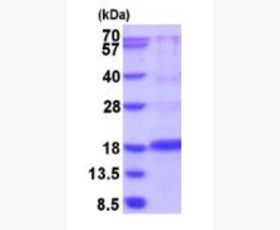Recombinant Human α-Parvin/PARVA/MXRA2
| Product name: | Recombinant Human α-Parvin/PARVA/MXRA2 |
| Source: | E. coli |
| Purity: | Greater than 95% as determined by reducing SDS-PAGE. |
| Buffer Formulation: | Supplied as a 0.2 μm filtered solution of 50mM Tris, 150mM NaCl, 40% Glycerol, pH 7.4. |
| Applications: | Applications:SDS-PAGE; WB; ELISA; IP. |
| Storage: | Avoid repeated freeze/thaw cycles. Store at 2-8 oC for one month. Aliquot and store at -80 oC for 12 months. |
| UOM: | 100ug/50ug/200ug/1mg/1g |
| Source | E. coli |
| Description | Recombinant Human alpha-Parvin is produced by our E.coli expression system and the target gene encoding Met1-Glu372 is expressed with a 6His tag at the C-terminus. |
| Names | Alpha-Parvin, Actopaxin, CH-ILKBP, Calponin-Like Integrin-Linked Kinase-Binding Protein, Matrix-Remodeling-Associated Protein 2, PARVA, MXRA2 |
| Accession # | Q9NVD7 |
| Formulation | Supplied as a 0.2 μm filtered solution of 50mM Tris, 150mM NaCl, 40% Glycerol, pH 7.4. |
| Shipping |
The product is shipped on dry ice/ice packs. |
| Storage |
Store at < -20°C, stable for 6 months after receipt. Please minimize freeze-thaw cycles. |
| Purity |
Greater than 95% as determined by reducing SDS-PAGE. |
| Endotoxin | Less than 0.1 ng/µg (1 IEU/µg) as determined by LAL test. |
| Amino Acid Sequence |
MATSPQKSPSAPKSPTPKSPPSRKKDDSFLGKLGGTLARRKKAKEVSELQEEGMNAINLPLSPIP FELDPEDTMLEENEVRTMVDPNSRSDPKLQELMKVLIDWINDVLVGERIIVKDLAEDLYDGQVLQ KLFEKLESEKLNVAEVTQSEIAQKQKLQTVLEKINETLKLPPRSIKWNVDSVHAKSLVAILHLLV ALSQYFRAPIRLPDHVSIQVVVVQKREGILQSRQIQEEITGNTEALSGRHERDAFDTLFDHAPDK LNVVKKTLITFVNKHLNKLNLEVTELETQFADGVYLVLLMGLLEGYFVPLHSFFLTPDSFEQKVL NVSFAFELMQDGGLEKPKPRPEDIVNCDLKSTLRVLYNLFTKYRNVELEHHHHHH
|
| Background | Alpha-Parvin (PARVA) is a member of the Parvin family. PARVA contains two CH (calponin-homology) domains. PARVA is widely expressed, with highest levels in heart, skeletal muscle, kidney and liver. PARVA interacts with integrin-linked protein kinase and probably with actin and the LD1 and LD4 motifs of PXN. PARVA may play a role in the regulation of cell adhesion and cytoskeleton organization. PARVA is also involved in ciliogenesis. |














